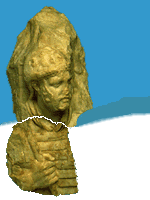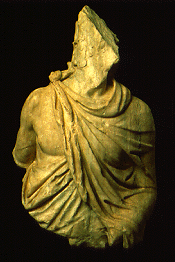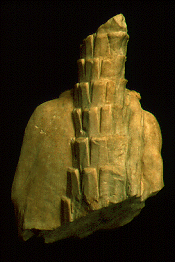

3. Male Torso Draped in a Mantle and Leaning against a Palm Tree (MNR 310252)
inv. no. 310252
max. h. 053 m; max. w. 0.34 m
Pentelic marble
The figure is destroyed from the waist down; it is missing almost all
of the head, the right forearm, the wrist, and the left hand. The mantle
is extensively chipped.
 |
 |
The figure depicts a male personage of mature age, in a standing position and dressed in a mantle fastened by a bulla on the right shoulder. The drapery leaves uncovered the right shoulder and breast as far as the armpit. The left arm is brought forward over the abdomen and the left hand probably held an attribute; the right arm hangs down along his side. The face is completely lost. A small portion of the neck remains, along with locks of curly hair.
The back of the figure is not finished but only superficially worked over. The figure leans against the trunk of a palm tree, which continued upward to form a palm-frond capital (MNR 310255). Applying Vitruvius's proportions of the human figure yields a total height for this personage of 1.12 m.
According to the theoretical reconstruction offered here, this figure, together with its counterpart (MNR 310256), constituted the colonnaded part of the structure. The use of male and female figures as supports for the entablature of buildings has a very long tradition and can be divided into two typologies, telamones and caryatids. The former betray the effort required to support the overlying architecture, while the latter in no way emphasize their weight-bearing function. Both appear in various positions and with diverse attributes. Caryatids are frequently, but not exclusively, female. In the Roman world the most significant example is provided by the Forum of Augustus, where the caryatids symbolize conquered regions and subjugated peoples. This is the message that Vitruvius recognized in such figures, which are eternally freighted with this symbolic function.
This figure, which reveals no effort in supporting the structure, belongs to the category of caryatids. In the absence of attributes, it is difficult to advance any theory about his identification. It is evident, from both his function and the way he wears the mantle, that he cannot be an aristocratic personage. In all probability he represents a personification. Given the association with a palm tree, the conquest of Judaea, an event of the highest importance in the history of the Flavians, immediately comes to mind.
Bibliography
Bibliography: Hartwig 24-25, pl. III, 3; Koeppel (1980) 15-16, 19; 22, n. 9, fig. 9; Di Mino and Bertinetti (1990) 141, fig. 117 g (R. Paris), with earlier bibliography.Catalogue entry by Rita Paris
Copyright ©1997, 2002 Ministero per i Beni Culturali e Ambientali, Soprintendenza Archeologica di Roma and the Kelsey Museum of Archaeology, University of Michigan. All rights reserved.
 |
 |
 |
 |
 |
 |
 |
 |
 |